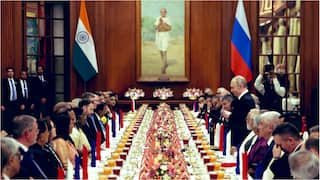Economic Survey 2022: What Is Barbell Strategy And How Modi Govt Used It To Cushion Covid Impact
Economic Survey 2022: The report detailed how Modi government did away with Waterfall method, a conventional policy approach, and went for the Barbell strategy to tackle challenges posed by Covid-19.

New Delhi: Union Finance Minister tabled the Economic Survey 2022 in Parliament on Monday, setting the stage for the presentation of Union Budget for 2022-23 on February 1. In the survey, the government explained how the Barbell strategy was put to use to cushion the Covid blow.
The Barbell strategy had found mention in last year's survey too.
The Economic Survey 2022 detailed how the Narendra Modi government did away with the Waterfall method, the conventional approach for framing policy across the world, and went for the Barbell strategy to take on the economic challenges posed by the Covid pandemic.
The last two pandemic years have been extremely challenging for policy-making around the world, as the mutating virus caused repeated waves, resulting in travel restrictions, supply-chain disruptions and global inflation, the survey said.
Faced with this uncertainty, the Government of India opted for the Barbell strategy, which it had explained last year as a common strategy “used in financial markets to deal with extreme uncertainty”.
ALSO READ | Economic Survey 2022 In Pictures: Key Figures And Points Explained
What Is Barbell Strategy?
The Barbell strategy combines different safety-nets to cushion the blow on vulnerable sections of society or businesses, the survey report said. It entails a flexible policy response based on a “Bayesian updating of information”.
The survey said real-time information-based policy adjustment was made to tackle these challenges.
Explaining how financial markets uses the strategy to deal with extreme uncertainty, by combining two seemingly disparate legs, the report remarked: “As some readers will have guessed, the iterative leg of this strategy is the same as the “Agile” approach that uses feedback-loops, and real-time adjustment.”
The ‘Agile approach’, the survey said, is an intellectual framework that is increasingly being used in fields like project management and technology development.
“In an uncertain environment, the Agile framework responds by assessing outcomes in short iterations and constantly adjusting incrementally,” it said.
The conventional Waterfall approach entails a detailed, initial assessment of the problem and then a rigid upfront plan for implementation, pre-committing to a certain path of action.
The Barbell strategy, in contrast, assumes a worse possibility initially, and then decides the response going step by step through a feedback loop.
ALSO READ | Economic Survey 2022: Retail Inflation Came Down To 5.2% While WPI Ran In Double Digits
What Steps Were Taken Under Barbell Strategy?
According to the survey, the government opted for a “careful mix of emergency support and economic policy actions” so cushion could be provided against the pandemic-induced shocks even as efforts were made to “flexibly adapting to an evolving situation”.
Listing the measures taken during the first wave of the pandemic, the survey said the government focused on saving lives through “emergency policy actions”, which included the imposition of a stringent lockdown when cases were still few. This, it said, allowed the government the necessary time to ramp up infrastructure for testing, create quarantine centres and put in place other facilities.
As the government realised that lockdowns and quarantines were disrupting economic activity, it put in place economic safety nets that included “world’s largest free food program”, besides direct cash transfers and relief measures for small businesses, the report said.
Meanwhile, the Reserve Bank of India provided monetary support to the economy.
These safety net provisions continued as the second wave hit, and were extended further as and when required.






































